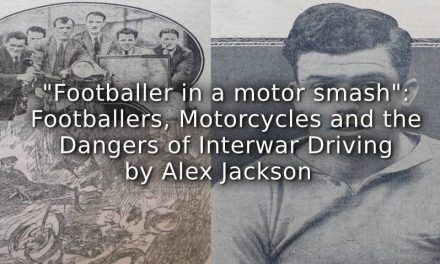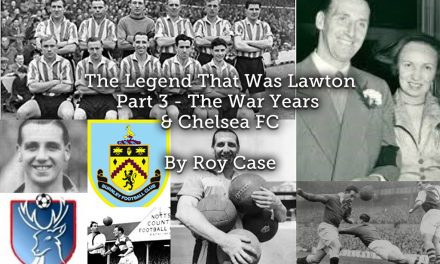“The colour red is widely recognised as being synonymous with Welsh culture and heritage, with Cardiff the proud capital of the country. The colour also holds strong spiritual significance in Asia”
[Vincent Tan, June 2012].
Alongside Hull City’s transformation to Hull City Tigers, there is perhaps no incident more synonymous with ‘modern football’ than Cardiff City’s change from blue to red (and back to blue again). The decision by maverick owner Vincent Tan to change the shirt colour of the team he had recently taken over, reverberated across the football world. Anyone not connected with football would perhaps find it difficult to relate to the distress of a change in shirt colour, but all football fans empathised with the distress of the Cardiff City fans. What made matters worse for the Cardiff followers was the drastic change in colour from blue to red. It was not a subtle difference but a monumental shift in the identity of the whole club. The bluebird on their crest was dwarfed by a red dragon from the Welsh national flag. The nickname of ‘The Bluebirds’ remained but much had changed of the club’s distinctiveness.
Blue and red are significant in football, many rivalries across the world are symbolised by these two colours. Liverpool and Everton; Manchester United and City; and AC and Inter Milan, all these famous cities are split down the middle by these two colours. If a new owner was to come into any of these cities and make a transition from red to blue or vice versa, the decision would upset thousands if not millions of fans. A colour is an identity for football fans, something that symbolises their beliefs. It goes further than football, the colour of your front door, your tie for work, your tattoo on your arm or the wallpaper in your front room are often swayed by footballing ideologies. If your team plays in red and you paint something red it is a subtle way of proudly displaying your love for your team, in the same way that the decision to not have something the colour of your rival is a way of distancing yourself from other views. Football is phenomenally tribal at times and the best illustration of this is colour.
Take Dortmund’s ‘Yellow Wall’. Of course the volume of passionate supporters it has makes it famous, but the yellow colour gives them uniqueness. Therefore, changing Cardiff’s colour from blue to red was so significant and upsetting to so many. Football fans had a look at their surroundings and realised how much the colour of their team influenced their life. Take away that specific colour and some fans would lose their relationship with their club, not to say they would stop supporting them, but their individual ways of displaying their colours would be stripped away.
This Cardiff City dilemma is terrible for football fans when viewed anachronistically. However, it is important to remember that all club colours were decisions made by individuals over one hundred years ago. Not only this, but many teams have changed colours in their history and it will be interesting to examine these colour changes in the context of the uproar that the Cardiff colour change received in 2012.
Bill Shankly making Liverpool all Red
November 25th, 1964 marked the first time that Liverpool wore all red. It was a European Cup first round tie where Liverpool ran out winners by three goals to nil. However, the headlines after the game were centred around the new red kit that was on display, and the ‘Red Shirted Crusaders of England’ were born. Shankly had changed the kit from red shirts, white shorts and white socks with a red trim to an all red strip. The strip was gradually introduced, red shirts and shorts at first in cup competitions then all red in the FA Cup and in Europe. Slowly but surely the kit was all red and by May every game was played in the all red strip. Liverpool went on to win the FA Cup at the end of that season for the first time, which helped cement its place as the new strip of Liverpool FC.
The reasoning behind the change, according to Shankly, was psychological. In typical Shankly form he was proud to discuss the importance of having an all red kit:
“we switched to all red and it was fantastic. The introduction of the all-red strip had a huge psychological effect. I went home that night and I said to my wife Ness: “You know something… tonight I went out onto Anfield and for the first time there was a glow like a fire was burning.
Our game against Anderlecht was a night of milestones. We wore the all-red strip for the first time. Christ, the players looked like giants. And we played like giants.”
It is interesting the lack of negative reaction that Shankly received for making this change. In comparison to Cardiff City’s change of colour, this was a lot lower key. It was a change made by a relatively new, albeit popular manager. The newspaper report from the Anderlecht game did say that ‘Liverpool, with vivid red shorts which even goalkeeper Tommy Lawrence wore, looked strange’. This quote does display some scepticism, rather than criticism, towards the colour change. Winning the FA Cup and being under the stewardship of the inspirational Shankly no doubt aided the colour shift and put Liverpool fans at ease. This all red strip is still synonymous with Liverpool today, so this change was clearly a successful one for Shankly and Liverpool.
Malcolm Allison changing Crystal Palace from Claret and Blue to Red and Blue Stripes
Vincent Tan was vilified for coming into a club and changing everything. Malcolm Allison did very similar when he became manager of Crystal Palace and changed their identity in 1973. Allison arrived at Palace with only seven games remaining of the 1972-73 season. Despite his experience he was unable to prevent his new side from being relegated into the Second Division. Allison arrived at Palace with a wealth of awards to his name. These had been accrued from a successful coaching career during his time as assistant to Joe Mercer at Manchester City and his work alone as manager. Allison had won the First Division, Second Division, FA Cup, League Cup and Cup Winners Cup before his arrival. This is important to remember when pondering the difference in reaction to Tan’s changes at Cardiff nearly forty years later.
With his new side now sat in the Second Division, Allison set about making momentous changes to raise the profile of the club. He began by replacing the old nickname of ‘The Glaziers’ with ‘The Eagles’ which was inspired by Benfica in Portugal. Then he replaced the traditional Claret-and-Blue kits with the Barcelona and Levante inspired Red and Blue stripes that remain today. As well as this, Allison introduced the all-white strip with a red and blue sash that is also still synonymous with the club nowadays. He was fixated with raising the profile of Palace and that was the reasoning behind the kit changes and the hat choices. Allison began wearing his famous fedora hat to attract attention and distract the other team. This tactic was confirmed to be successful when Allison heard whispers from the Scarborough dressing room discussing his hat saying; “What do you think about that big-headed bastard? First chance we ever have of getting some publicity and he comes along in that stupid hat”.
These changes were substantial but did not exactly produce the results Allison was expecting as Palace slumped to a second successive relegation. Allison spent three full seasons at the club and oversaw two relegations, yet his huge overhaul of the club’s identity remained. Other than a positive cup run, Allison’s reign at Palace was a failure yet his popularity was very high. He resigned in May of 1976 and the news was surprisingly upsetting to Palace fans. As one of Allison’s former players said; “Malcolm Allison put Palace on the map. No other man could single-handedly take a club from the First Division to the Third Division and still become an instant hero”. His charismatic persona and famous fedora hats endeared him to the Palace fans, it certainly could not have been the results.
Allison, like Shankly, had the love of the fans which aided the reaction to his colour changes. Both men had a lot of charm which seemed to hypnotise their besotted supporters, allowing for colour changes. Tan did not have this relationship with the Cardiff fans which may explain the backlash to his kit changes. However, it is still surprising that despite the vast changes that Allison made in terms of nicknames and kit changes, partnered with poor results on the pitch, he is still remembered so fondly by Crystal Palace fans. For every reason that it is clear Tan made a wrong decision for Cardiff City, the same reasons apply to Allison at Palace, if not worse. The reasoning behind Allison’s adoration by Palace fans is baffling, yet explains why they remained.
There are far too many individual cases of kit changes to individually analyse. From Jimmy Hill adapting Coventry City into a new team by ‘coining the nickname Sky Blues after changing the kit, writing a new club song and introducing the first modern match programme’. When John Bond took over at Bournemouth he too was keen to change the image of the club. ‘One of the first things Bond did was change the club’s playing kit, dispensing with the famous cherry red shirts in favour of the famous red and black stripes of AC Milan’. Then there is Graham Taylor and his taste for the colour red. He introduced red into the traditional gold and black colours of Watford in 1976. Taylor had moved from Lincoln City, who play in red and white, and requested that red be included in the club’s colours. Watford have played in yellow, red and black ever since. All of the managers mentioned influenced the colour change of their respective clubs’ kits and the idea was received favourably. These five examples may confuse as to why Tan is so hated for his changes at Cardiff. To only examine kit changes that have been received favourably and persist today would be to present a narrow argument. There have been examples of kit changes that did not get welcomed by fans and that do not remain today.
Stockport County, emulating Argentina and the Falklands War
“I got the Argentinian World Cup strip with the County badge sewn on it from a great friend at Adidas, and boots and fifty balls, all for nothing, but soon after I left the Falklands War broke out and they couldn’t use the strips any more.”
[Mike Summerbee, 1979]
Mike Summerbee’s Stockport County were readying themselves for the beginning of the 1979-80 season. Summerbee had been appointed player-manager toward the end of the 1978-79 season. The club wanted to know if he had any contacts from his illustrious playing career that could help source a new kit. Summerbee was sponsored by Adidas and had contact with the company owner, Adi Dassler. Argentina had just won the 1978 World Cup and Dassler had a few spare sets of the shirts. Dassler had the Argentina badge replaced with the Stockport County one and they were sent to Greater Manchester.
Summerbee faced some opposition to changing the colours from royal blue and white to light blue and white stripes from the County fans, but overall the changes were welcomed. The kit outlasted Summerbee’s reign at the club who left them in 1979 and the Argentina kit remained until April 1982. This date is of course synonymous with the outbreak of the Falklands War. Stockport had not done what Bournemouth did with AC Milan and emulated a kit design, these kits were Argentina strips with the badge replaced. In fear of causing any upset to the public or receiving any backlash toward the club and players, Stockport County were requested to change their kit mid-season. This was approved, and County became the first team ever to change their kit before the end of a season and it was due to war.
This is completely different to Tan at Cardiff and the reason behind the change from red back to blue. However, it is another example of a kit having to be reverted to its previous design. Summerbee cannot be blamed for being a maverick or a dictator for introducing a new colour scheme. It is also fair to presume that had it not been for the Falklands War, County would still be playing in Argentina style kits. This incident provides an interesting view on the role of politics on football and illustrates that despite Tan’s upset of the Cardiff fans, he did not face political backlash from the colour change like Stockport did.
The Red Bull Era
All the aforementioned incidents are focussed on clubs within the English leagues. However, if Cardiff’s kit change is viewed as the ‘modern football’ revolution, it is nothing in comparison to what Red Bull have done with RB Leipzig, New York Red Bulls, Red Bull Brasil, Red Bull Ghana and F.C. Red Bull Salzburg. Again, it would be too lengthy to individually dissect the involvement with Red Bull in each of these clubs, instead it will be the case study of F.C. Red Bull Salzburg that will be examined.
Red Bull purchased SV Austria Salzburg in 2005 and rebranded them as Red Bull Salzburg. Red Bull were not attempting to financially support a club but denounce all that occurred before they took over. The takeover was an undisguised attempt to replace a club’s identity and traditions – built up over the previous 72 years of its existence by supporters and the community. Red Bull wanted to erase Salzburg’s history and stated that the club began in 2005 when Red Bull took over. As well as this, when Red Bull took over, one of their first actions was to rename the team and outfit them in the colours of the energy drink (red, yellow and blue). They had replaced the traditional violet and white colours of the team with the Red Bull colours. This hugely upset fans yet Red Bull stuck to its decision despite fan protests that went far beyond Austria’s borders’. The fans felt disenfranchised with their club so they ultimately formed a new football club using the club’s former name (SV Austria Salzburg). The new club were to play in the traditional violet and white and gained a large fan base due to the many fans that lost interest in the Red Bull side.
This is an extreme example of the backlash that can be received by changing the identity of a club. The Salzburg fans had their club taken from them, stripped bare and replaced. Vincent Tan’s changes at Cardiff could look miniscule in comparison to Red Bull but it is possible to draw comparison. Any Cardiff fan could look at Salzburg and the rest of the Red Bull clubs and see how far owners can change the football club and the fans are left powerless. They took a stand to stop their owner from thinking he could change their club totally. Unfortunately for the Salzburg fans they could not sway their new owners. In all fairness to Tan, he made changes that were not well received and ultimately, he backed down. Tan certainly is not a hero but, in comparison to the Red Bull owners, he is a fair owner. To remove everything that a whole fan base holds dear is disgusting, football fans devote their lives to their clubs and it is scary to see how easy it is to obliterate it all.
Today, it appears it is never going to be welcomed to change the main colour of a team’s home shirt. Vincent Tan has faced a lot of abuse for his colour changes, yet most managers that preceded him made drastic changes without the same animosity. This was mainly because the changes made were not as drastic as at Cardiff. Liverpool, Bournemouth, Watford and Stockport made subtle changes, and these were welcomed by the fans. It is inevitable that kit styles will change, and colours may mildly adapt to the times, but huge changes can distance supporters from their clubs. The only example that seems to conflict all of this is Crystal Palace, Allison seems to have been forgiven for having a good CV and a large fedora hat. Having said this, claret and blue is not too far away from red and blue, so the change could have been easy to accept. When it comes to Cardiff and Salzburg it is clear to see why the fans were so distressed, the alterations made at these clubs were a step too far. It is horrifying for any football fan to witness what can happen to their beloved clubs with diminutive care for their interests. The fact that Cardiff returned to blue is credit to the Cardiff fans, and that Salzburg had to start a new club illustrates the influence and obstinacy of Red Bull. It is never right to change the colours of a club without either consulting the supporters first or only making minor changes. Colours are extremely significant to football fans and for anybody to come into a club and presume a full change to be accepted does not appreciate football nor do they understand football fans. The history and traditions of each club is more important than any volume of money to any supporter, and long may that last.
Article © Peter Jones
First published in “The Football Pink” and reproduced by kind permission of the author











